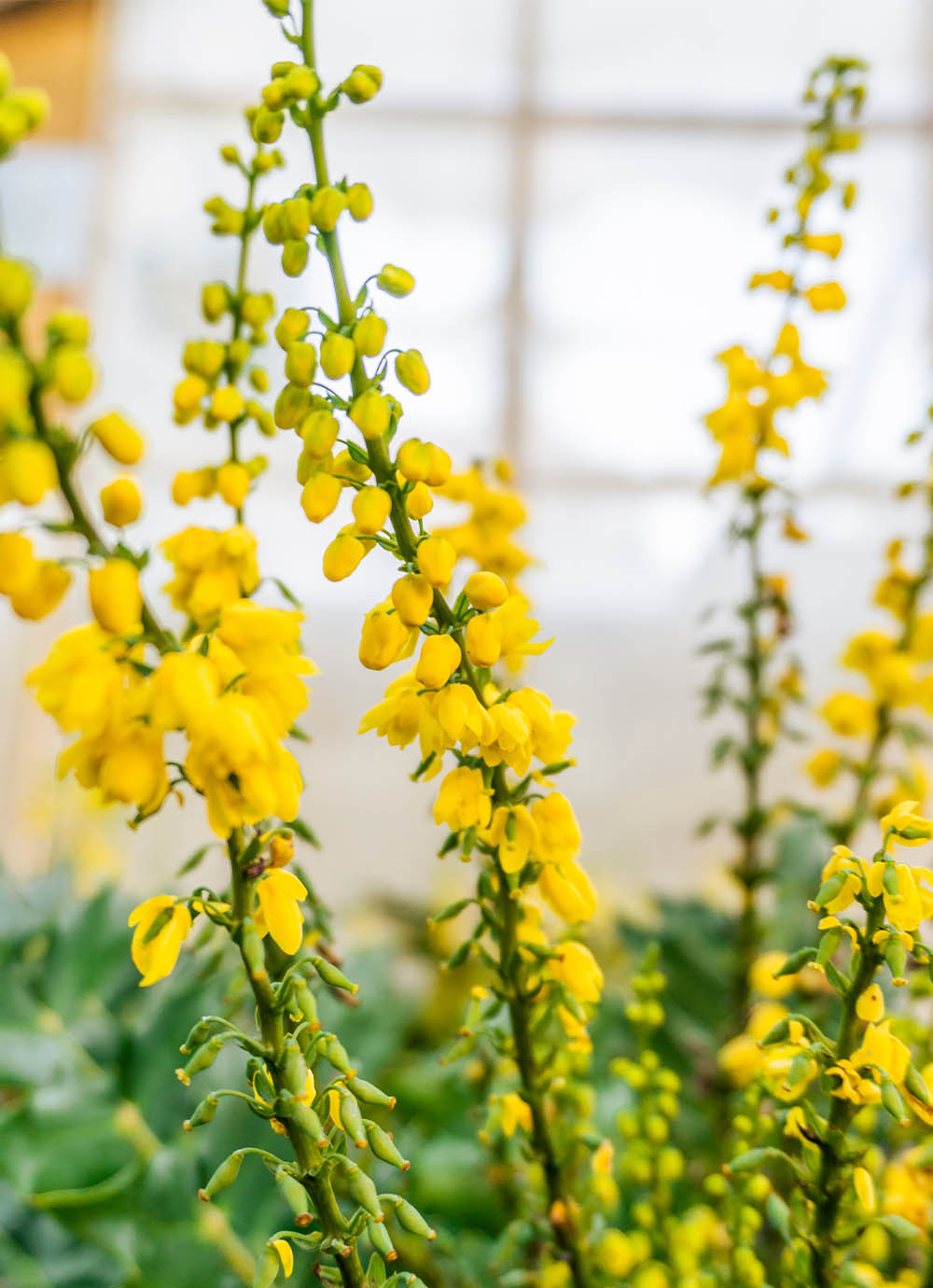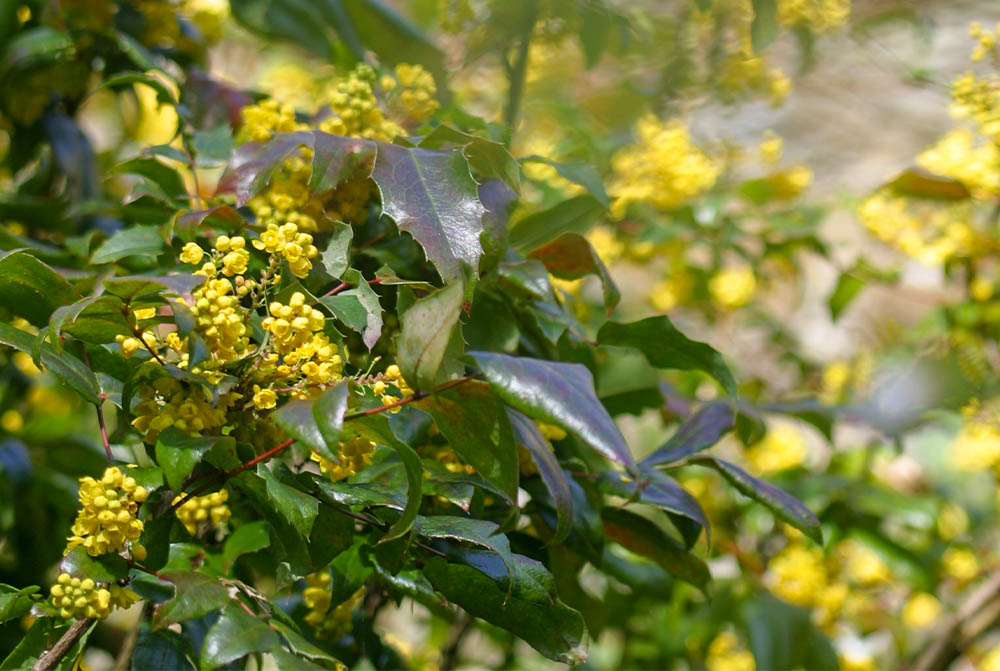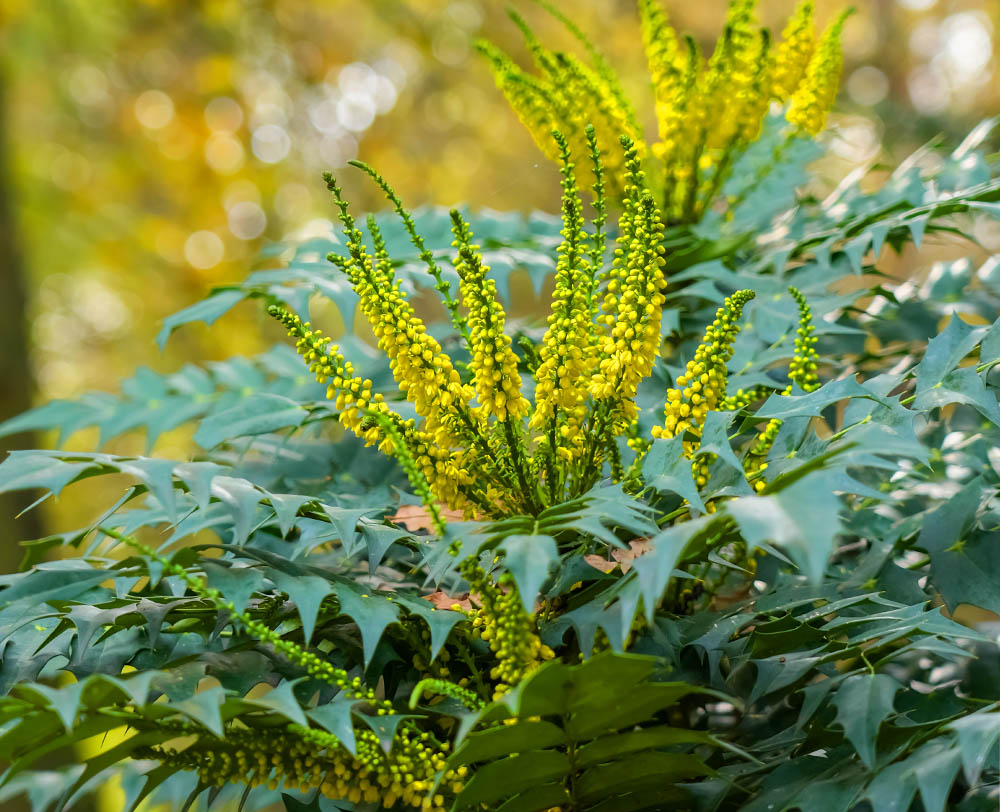Plant Focus: Mahonia
Bold, Evergreen shrubs with bright winter flowering, to provide year round interest in gardens
Mahonia is a genus that contains approximately 70 species of plants. These consist mainly of shrubs, but also contains a few species of small trees. It’s often known by its more common English name ‘Oregon Grape’, referring to the dark berries it grows in Autumn. Most species are native to North and Central America, as well as parts of Eastern Asia, and Japan. The split nativity of Mahonia was likely caused by the breakup of the continents. Whilst they may have grown in a single cluster millions of years ago, the continental drift that separated Asia and America would have likely left some species of the Mahonia genus on either side, to grow and evolve independently.
Key Characteristics:
✓ Evergreen shrub
✓ Variable height of 1m to 4m
✓ Prefers partial shade
✓ Thrives in well-drained soil
✓ Bears Autumnal fruit and winter flowers
✓ Can be planted in ground cover or as part of a border

Mahonia × media ‘Charity’
The Genus was first introduced to the United Kingdom in 1823, through the most common American grown species: Mahonia aquifolium. Mahonia species are known for their tough, spiny, evergreen leaves, which provide striking year-round interest. Despite their autumn berries, Mahonia plants are most loved by horticulturalists for their Spikes of bright yellow flowers, that often shoot upwards, and present in winter to early spring. It makes them a very popular choice in gardens and landscaping projects due to their autumn and winter visual interest, a time during which gardens can struggle aesthetically, when many plants are dormant, and lacking in colour. Mahonia plants can grow up to between 1.5-4 metres in height, with some species being ideal for lower ground covering due to their larger spread of foliage, and others being well suited to being planted at the back borders, thanks to their upright growth habits. Mahonia plants thrive in well drained soils, and whilst they prefer partial shade, they will tolerate full sun or deep shade. In order to give Mahonia varieties the best chance of thriving, be sure to plant them in an area with a reasonable degree of shelter from the elements. Cold, icy winds can cause some damage to the foliage of these plants.
Fun Fact
The Genus is named after Bernard McMahon, an Irish-American horticulturalist, who was one of the stewards of plant collections from the Lewis and Clark expedition across America, through the land acquired in the Louisiana Purchase in the early 1800s.
Mahonia Varieties we recommend:

Mahonia aquifolium
Mahonia aquifolium
Low spreading, evergreen shrub, with particularly prickly foliage, that produces clusters of yellow flowers in winter. Reaches a maximum height of 1 metre. The fruits are edible, but need some sweetening for human palettes.
Mahonia aquifolium ‘Apollo’
Slightly slower growing Cultivar of Mahonia aquifolium, that produces bigger clusters of bright yellow flowers in winter, with black berries in Autumn. Given the RHS Award of Garden Merit.
Mahonia x media ‘Charity’
An upright evergreen shrub that can grow up to 4m tall. Its leaves are pinnate, and contain up to 21 leaflets on either side. Tall spires of yellow flowers up to 35cm grow upwards during the late Autumn and early Winter.
Mahonia eurybracteata ‘Soft Caress’
An upright, compact shrub that grows to about 1.5 metres in height, and characterised by its slender, spine free leaves. Flowers earlier than other Mahonia plants, in late summer and autumn, with blue and black berries in winter.
Mahonia × media ‘Winter Sun’
A medium sized bushy, evergreen shrub which has a tendency to grow upright. It produces small, fragrant yellow flowers in winter, that turn to ornamental blue-black berries afterwards.

Mahonia eurybracteata ‘Soft Caress’

Mahonia × media ‘Charity’
Mahonia japonica
A species of Mahonia native to Japan and the surrounding area. It features large, pointed evergreen leaves, with fragrant, light yellow flowers that droop and spread in sprays, from late autumn to early spring. Blue back berries follow in late winter/early spring.
Mahonia x media ‘Lionel Fortescue’
A Cultivar of the Mahonia x media hybrid which produces flowers earlier in the year than some of the more common varieties. Bright yellow, upward pointing racemes of flowers bloom in Autumn/early winter, being followed by winter berries.
Mahonia nitens ‘Cabaret’
A compact, upright shrub with glossy, dark green foliage. Intriguingly can produce orange coloured flowers, in contrast to most other species in the genus, during summer and autumn. Blueish-grey berries follow in winter. RHS Award of Garden Merit recipient.

Mahonia japonica
How to grow and care for Mahonia:
When planting Mahonia, the best time to do so is in the autumn or early spring, when the soil is moist and temperatures are cool. To prepare the planting area, combine organic matter within the soil to enhance its moisture retention capability and improve drainage. Dig a hole that is twice the size of the root ball and mix in some compost or organic matter to improve soil fertility. Mahonia plants prefer well-drained soil and partial to full shade. They can tolerate some sun, but too much can scorch their leaves. Choose a site that is protected from strong winds, as they can damage the plant. Mahonia plants prefer consistent moisture but are generally quite hardy, and can tolerate periods of drought once established. Water deeply once a week during the growing season and reduce watering in the autumn and winter. Try to avoid continually wet soil with Mahonia, as this may cause damage to the plant. No regular pruning is required, but extended shoots on Mahonia x media can be cut back to a sideshoot or a rosette of foliage after flowering to improve their shape. Mahonia aquifolium may need occasional shaping, so be sure to prune when required with this species. Mulch in autumn with weed-free organic matter, and remove any dead, damaged, or diseased branches on a regular basis. Mahonia plants can be propagated by seed, division, or stem cuttings, and will provide best results when propagated in the spring or autumn.
Pests and diseases:
Generally, Mahonia species are pest and disease-free, however some species can be susceptible to certain stem rusts, in particular ‘cereal rust’. This is caused by a fungus called Puccinia graminis, and causes discolouring of the branches and stems of the plant, turning them a crimson/brown colour, hence the name ‘rust’. If spotted, the best course of action is to cut away any infected stems/leaves at the earliest sign, and dispose of them far away from other plant life. The best course of action to prevent rust developing is to ensure the plants have proper airflow, and to avoid watering anywhere but the base of the plants.
To learn more about the different types of Mahonia that we grow and sell, speak to the G Team today.

